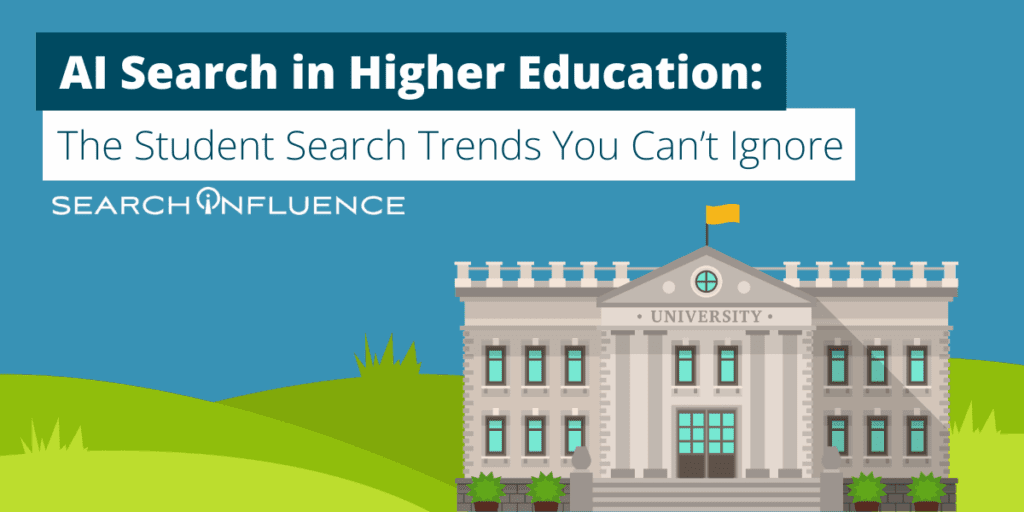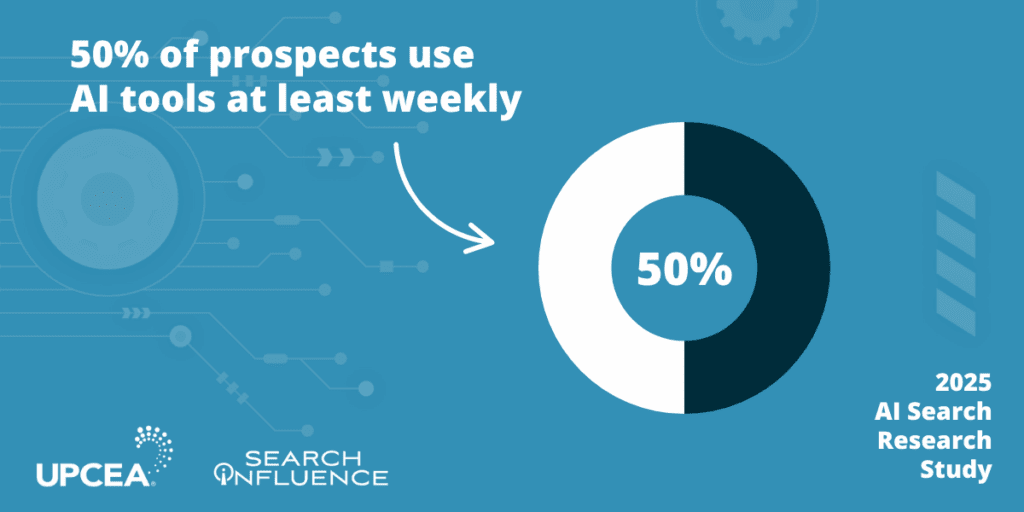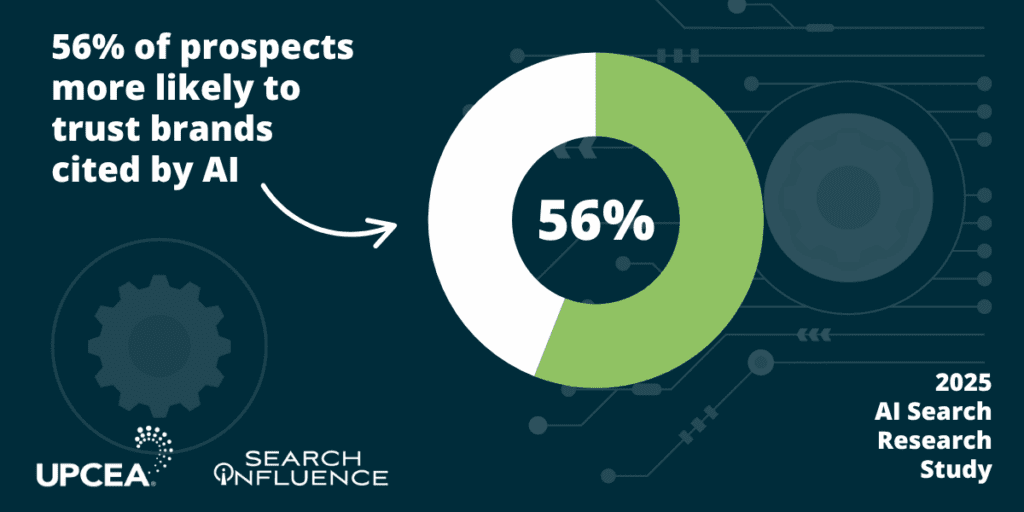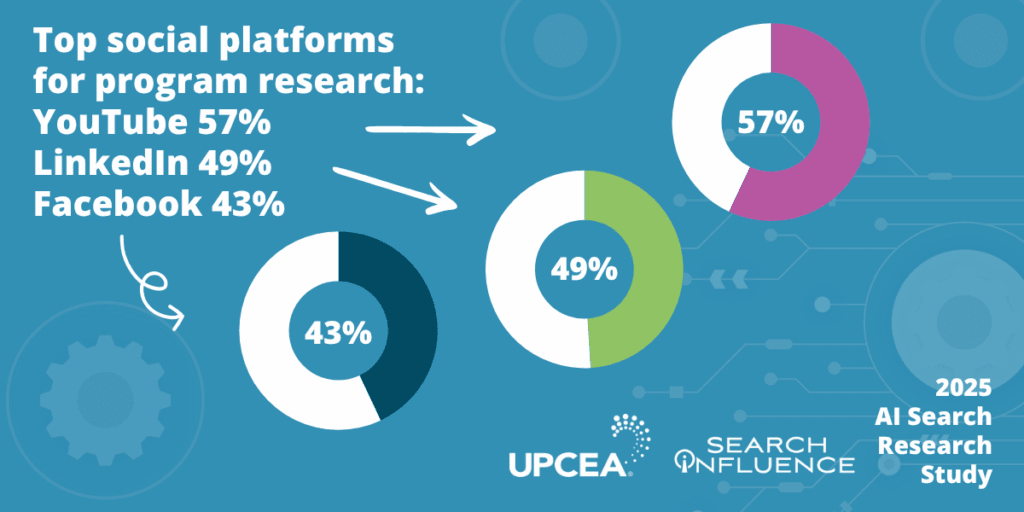Industry Insights
Valuable insights from UPCEA's trusted corporate partners.
AI Search in Higher Education: The Student Search Trends You Can’t Ignore
Summary
Learn how prospects search in 2025 with UPCEA and Search Influence’s AI Search in Higher Education Study, and discover the marketing strategies you need to adapt.

Search behavior has evolved, and so has the path to enrollment.
Generative AI tools like ChatGPT, Gemini, and Google’s AI Overviews shape how people gather information, verify details, and form opinions. For higher education marketers, that means program visibility depends on showing up wherever students look for answers, not only in search results but across the expanding landscape of AI and digital discovery.
A new joint study by UPCEA and Search Influence, AI Search in Higher Education: How Prospects Search in 2025, captures how today’s prospective students search and decide. The data shows that learners now move fluidly between Google, AI platforms, and video when exploring their options online.
To reach and engage this audience, institutions must be visible and consistent across multiple channels.
About the Research Study
The 2025 AI Search in Higher Education Research Study examined how prospective students search for professional and continuing education programs in the age of AI.
The survey gathered responses from 760 adults ages 18–60, all interested in advancing their education or career. Participants represented a mix of educational backgrounds, from high school graduates through graduate degree holders, and most were employed full-time. This group reflects today’s growing market of adult learners and offers insight into broader enrollment trends.
The research explored how students use search engines, AI tools, social platforms, and other digital channels in their searches and how these behaviors influence enrollment decisions.
Here’s what the research reveals about student search trends in 2025, plus how your institution can adapt.
AI Search Has Become Mainstream

24% of students use AI-powered tools daily, 26% weekly, and 18% monthly.
Why This Matters
50% of prospects use AI tools at least weekly. If AI tools can’t find you, half your audience won’t either.
AI platforms are becoming central to how prospective students discover programs and institutions, influencing the options they explore next. The programs that surface first in responses shape what prospects believe their options are.
Without clear, accurate visibility across these tools, schools lose ground to competitors already earning space in AI-generated responses.
Tips to Adapt
Being visible in generative AI isn’t automatic. It requires content that’s structured, verifi able, and aligned with how these tools source and summarize information. Higher education institutions that pivot now will gain early traction with the prospective students using AI tools in their searches.
To adapt:
- Audit your AI presence. Use Google, ChatGPT, Gemini, and Perplexity to test queries your prospects might ask. Track how your institution is displayed (or excluded) and identify opportunities to improve relevance.
- Evaluate how competitors show up. Look at what programs, topics, or language other schools are using that prompt AI to include them in responses.
- Strengthen your site’s semantic structure. Use clear headings, entity-rich language, and schema markup to help AI tools understand and cite your content accurately.
- Make program pages citation-ready. Include credential names, outcomes, costs, and other fact-based elements that AI technology prefers when assembling responses.
Students Increasingly Trust AI for Program Research
32% of prospects have no concerns about using AI tools; 28% worry about accuracy, 7% privacy, with smaller groups citing plagiarism or environmental concerns.
Why This Matters
1 in 3 prospects trust AI tools for program research.
While some prospects express concerns about AI usage, trust in AI tools is growing fast. As that trust builds, AI-generated responses will carry even more weight in shaping perception, options, and decisions.
If your institution isn’t represented (or is misrepresented), you miss critical opportunities to increase trust early, often before a student reaches your website.
Tips to Adapt
To earn credibility in AI-generated content, your institution must be seen as a trustworthy source that’s consistent, verifiable, and worth referencing. That means aligning your content not just with what students search for, but with how AI tools evaluate and present information.
To adapt:
- Lead with authoritative content. Highlight faculty expertise, accreditation, program outcomes, and employer partnerships. These are signals of trust, both to students and to AI models sourcing content.
- Publish transparent program details. Include tuition, financial aid, admissions requirements, and FAQs. AI tools tend to favor straightforward, fact-based content when answering user queries.
- Update your content regularly. Stale or outdated information undermines trust. Make sure key pages reflect the current academic year, deadlines, and opportunities. (Bonus tip: AI favors fresh content.)
- Monitor how AI tools talk about you. Prompt Google AI, ChatGPT, and Gemini with your institution’s name and programs. If the answers are inaccurate or missing, update your web content to clarify and strengthen signals.
Google’s AI Overviews Influence Student Trust

79% of prospects read Google’s AI Overviews; 56% are more likely to trust brands cited in them.
Why This Matters
If you’re not in the AI Overview, you’re not being considered, and you’re not getting the application.
AI Overviews dominate prime screen real estate. Cited brands gain instant credibility with over half of readers. When your institution appears here, you’re not just visible… you’re validated. But if you’re missing, prospects will explore programs with universities that are present.
In a high-stakes, low-attention environment, the brands that show up first are the ones that make it into the prospect’s consideration set.
Tips to Adapt
Securing a spot in Google’s AI Overviews takes deliberate eff ort of foundational SEO tactics and more advanced AI / large language model (LLM)-focused techniques. These summaries are driven by what Google’s systems determine to be the most authoritative, structured, and clearly stated content available, and they pull from what’s easy to parse.
To adapt:
- Build authoritative content with structured data. Use schema markup, clear headers, tables of contents, key insights, and accurate facts to signal relevance and credibility. Structured pages help Google extract key points for AI-generated summaries.
- Answer questions before they’re asked. Expand FAQ sections and long-form content to address what students are likely searching for. The more precise and factual your answers, the more likely they are to be cited.
- Earn citations and backlinks that reinforce authority. Mentions from media outlets, government pages, or high-authority industry sites act as external signals of trust and improve your chances of inclusion (yes, even paid placements and awards!)
- Monitor who’s getting cited. Look at which institutions, programs, or even non-academic sites appear in AI Overviews for relevant terms. Identify content patterns, citation formats, and topic framing that you can apply or improve on.
Page One Visibility Still Drives Consideration
35% of prospects are “much more likely” to consider programs on page one of traditional search; 47% “somewhat more likely”; only 16% say no impact.
Why This Matters
82% of prospects are more likely to consider programs on page one of search results.
Page one is still the digital front door to enrollment. Even as AI tools rise in influence, traditional search results remain a primary source of program discovery. Students rarely scroll past the first few listings, and if your program isn’t visible at the top, it’s likely not being considered.
Tips to Adapt
AI search may be reshaping the landscape, but strong traditional SEO remains foundational. Your institution’s visibility in Google’s organic results is highly correlated to AI Overview visibility and directly impacts consideration and clicks for those who scroll beyond AI.
To adapt:
- Prioritize SEO for high-intent keywords. Target the terms prospective students actually use, including program names, degree levels, and career outcomes.
- Fix technical barriers. Ensure your site loads quickly, works on mobile, and meets accessibility standards so it ranks competitively and offers a frictionless experience.
- Refresh your top pages often. Keep program descriptions, outcomes, and cost details current and aligned with what students want to know. (Remember that bonus tip about fresh content? Organic search and AI favor up-to-date content.)
- Optimize for click-through. Use clear title tags, compelling meta descriptions, and structured data to earn attention and clicks from students scanning page one of search results.
Students Rely on Search Engines and University Websites
84% of prospects are extremely/very likely to use search engines for program research, and 63% are extremely/very likely to use university websites.
Why This Matters
You must invest in search and your website to stay competitive in the enrollment journey.
Search engines and university websites remain the primary tools students trust when exploring programs. Credibility is built through organic search and on-site experience. If your website is difficult to navigate or outdated, even strong rankings won’t convert.
Tips to Adapt
Success in traditional search depends on what students find when they click through. Your site and your SEO strategy must work in tandem.
To adapt:
- Keep your program pages updated and accurate. Ensure they reflect current outcomes, costs, deadlines, and credential details.
- Focus on UX alongside SEO. A well-optimized page must also load quickly, work across devices, and guide students toward action.
- Map student questions across both search and site content. Align on-page copy, meta descriptions, and internal navigation with how students search and what they want to know.
- Support SEO with strong internal linking. Connect relevant blog posts, FAQs, and related programs to help both users and search engines navigate your site effectively.
- Use analytics to identify drop-offs. If a high-ranking page isn’t converting, assess its content clarity, structure, and call-to-action strategy.
University Websites Are the Most Trusted Source
77% of prospects consider university websites as “extremely/very trustworthy,” compared to 66% for search engines.
Why This Matters
Prospects are still seeking information from university sites. They will still click sources featured in AI and go to organic results.
This makes your website your most credible enrollment tool. Invest in it.
Tips to Adapt
Trust is earned in the details. Your site should give prospects everything they need to feel confident in their next step: clear facts, authoritative signals, and an experience that reinforces credibility from the first click to the final inquiry.
To adapt:
- Build transparent, student-centered program pages. Go beyond marketing copy to include the facts students care about: tuition, modality, admissions steps, deadlines, and outcomes.
- Reinforce institutional credibility. Highlight faculty expertise, alumni outcomes, licensure rates, and employer partnerships. These proof points build trust quickly with prospects.
- Use schema markup to strengthen signals. Structured data helps search engines and AI tools extract accurate program information, reinforcing your authority in both platforms and perception.
- Show rather than tell. Include testimonials, student spotlights, and real outcomes to demonstrate value and connection, not just claim it.
Student Search Behavior Is Diversified Across Platforms
84% of prospects use search engines to research programs, and they also use AI tools (50%) and YouTube (61%) in the same way they do a search engine.
Why This Matters
Your content must perform across traditional search, AI, and video.
Students now move fluidly between Google, AI tools, YouTube, and social. Each platform serves a different purpose: quick answers, in-depth comparisons, peer validation, or visual walkthroughs.
Together, they form a research loop that shapes perception long before a student clicks “Apply.”

Tips to Adapt
Reaching today’s prospects means showing up with the right format, in the right place, at the right time. Whether they’re asking ChatGPT about career outcomes or watching a YouTube video on certificate options, your content needs to be structured for discovery and built for trust.
To adapt:
- Align content across formats. Repurpose your web content into short-form video scripts, AI-readable Q&A blocks, and traditional SEO pages that reinforce the same core message.
- Optimize YouTube strategically. Use keyword-driven titles, clear descriptions, transcripts, and organized playlists that match what students are searching for.
- Format content for AI visibility. Use semantically rich headings, structured data, and factual language that tools like Gemini and ChatGPT can easily cite.
- Test your presence across platforms. Search your institution and programs on Google, YouTube, and AI tools. Identify what appears, what’s missing, and where adjustments are needed.
Social Proof Shapes Enrollment Decisions
Nearly 7 in 10 prospects say frequent social media recommendations make them more likely to consider a product (18% “much more likely,” 50% “somewhat more likely.”)
Why This Matters
Peer-driven credibility directly influences program consideration.
Social platforms have evolved into search engines in their own right. Prospects use TikTok, Meta, and Reddit to explore programs, validate what they’ve seen on Google or AI tools, and hear real stories from real students. This growing trend in social search means your visibility in these spaces reinforces credibility and drives consideration across channels.
Institutions absent from these conversations risk losing share of voice to competitors who are consistently cited, shared, and seen.
Tips to Adapt
Social content should feel real, relevant, and shareable. You must build a presence that reflects your community, answers common questions, and encourages engagement over promotion.
To adapt:
- Post consistently with intent. Focus on timely topics, upcoming deadlines, or frequently asked questions to stay relevant in the feed.
- Use strong captions. Well-written copy can help your content surface in AI-generated search results and organic rankings.
- Optimize captions with keywords: Write optimized captions in the same way you would write a blog post to align with how prospective students search.
- Center student and alumni voices. Let your community speak to outcomes, challenges, and successes in their own words.
- Highlight real experiences through video. Short-form videos featuring students, faculty members, or behind-the-scenes moments often outperform highly produced promotional content.
AI Search in Higher Education FAQs
How is AI search different from traditional SEO?
AI search summarizes information from across the web, while traditional SEO ranks individual pages in search results. Instead of displaying a list of links, tools like ChatGPT and Google’s AI Overviews generate direct answers using the most authoritative and well-structured content available. To be included, your content needs to be factual, well-formatted, and optimized for semantic understanding, not just keyword relevance.
Can appearing in AI results actually drive enrollment inquiries?
Yes, if your program appears in AI results, you’re already in the student’s consideration set. Half of prospective students use AI tools weekly, often before they visit your website. Visibility here builds trust early, introduces your programs at the discovery stage, and directs students toward deeper engagement via your site or other channels.
What’s the risk of not adapting to AI search now?
If you’re not visible in AI-driven search, you’re not being considered. AI tools can’t surface what they can’t fi nd. Programs with weak SEO and unclear signals are often excluded from AI-generated results, even if they’re relevant. The good news: acting now puts you ahead of most institutions. Early movers will win visibility in both AI and Google, ensuring they’re found, considered, and chosen.
Turn Student Search Trends Into Enrollment Wins
The gap between how students search and how most institutions show up is widening.
While prospects move fluidly between search engines, AI, YouTube, and university sites, too many strategies are still stuck in single-channel thinking.
The new AI search research isn’t just a snapshot of behavior. It’s a wake-up call to act.
Download the AI Search in Higher Education Report from UPCEA and Search Influence to see what students expect, where your institution stands, and how to stay visible at every step of the enrollment journey.
Paula French is a Director at Search Influence, a leading AI SEO and digital marketing agency specializing in higher education. With over 15 years of experience crafting and leading digital marketing campaigns for major organizations, Paula has a proven track record of helping institutions like Tulane School of Professional Advancement effectively reach and engage their target audiences.
More Industry Insights:
